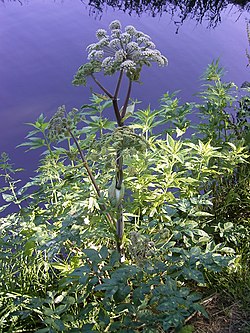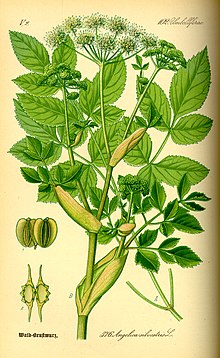This is an old revision of this page, as edited by 69.231.75.249 (talk) at 02:34, 16 February 2009 (→Species). The present address (URL) is a permanent link to this revision, which may differ significantly from the current revision.
Revision as of 02:34, 16 February 2009 by 69.231.75.249 (talk) (→Species)(diff) ← Previous revision | Latest revision (diff) | Newer revision → (diff)
| Angelica | |
|---|---|

| |
| Wild Angelica (Angelica sylvestris) | |
| Scientific classification | |
| Kingdom: | Plantae |
| Division: | Magnoliophyta |
| Class: | Magnoliopsida |
| Order: | Apiales |
| Family: | Apiaceae |
| Tribe: | Selineae |
| Genus: | Angelica L. |
| Species | |
|
About 50 species; see text | |

Angelica is a genus of about 60 species of tall biennial and perennial herbs in the family Apiaceae, native to temperate and subarctic regions of the Northern Hemisphere, reaching as far North as Iceland and Lapland. They grow to 1-3 m tall, with large bipinnate leaves and large compound umbels of white or greenish-white flowers.
Some species can be found in Purple Moor and Rush Pastures.
HEY BRENDA GISELLE
Cultivation and uses
Some varieties are grown as flavoring agents or for their medicinal properties. The most notable of these is Garden Angelica (A. archangelica), which is commonly known simply as angelica. Natives of Lapland use the fleshy roots as food and the stalks as medicine. Crystallized strips of young angelica stems and midribs are green in colour and are sold as decorative and flavoursome cake decoration material, but may also be enjoyed on their own. The roots and seeds are sometimes used to flavor gin. Its presence accounts for the distinct flavor of many liqueurs such as Chartreuse.
Seacoast Angelica (A. lucida) has been eaten as a wild version of celery.
A. sylvestris and some other species are eaten by the larvae of some Lepidoptera species including Bordered Pug, Grey Pug, Lime-speck Pug and the V-Pug.
A. dawsonii was used by several first nations in North America for ritual purposes.
A. atropurpurea is found in North America from Newfoundland west to Wisconsin and south to Maryland, and was smoked by Missouri tribes for colds and respiratory ailments. This species is very similar in appearance to the poisonous water hemlock.